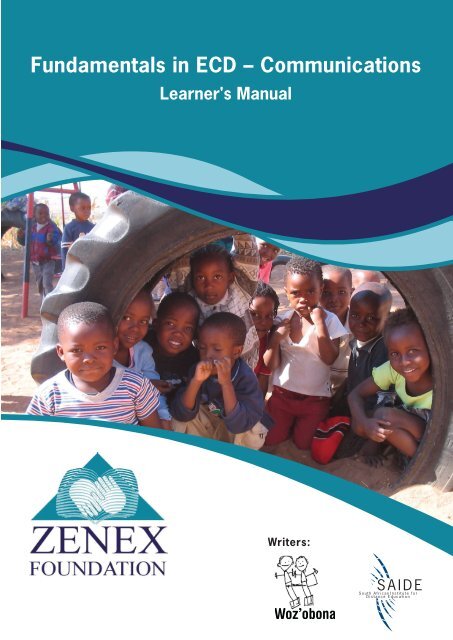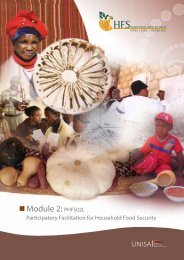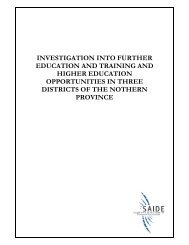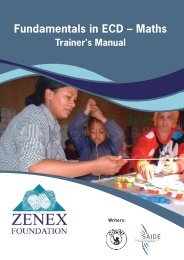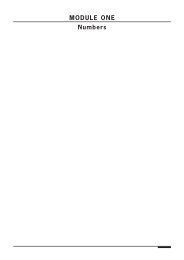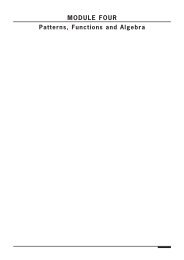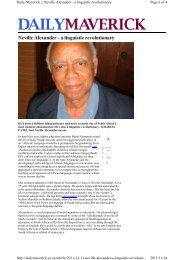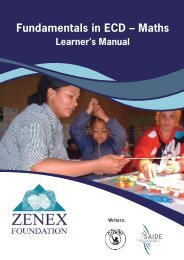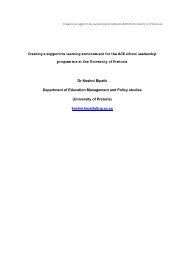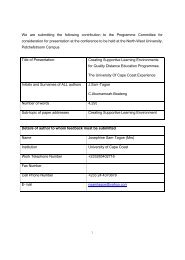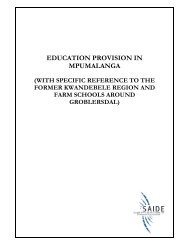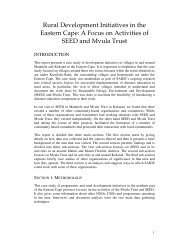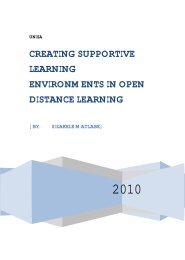Fundamentals in ECD â Communications - South African Institute for ...
Fundamentals in ECD â Communications - South African Institute for ...
Fundamentals in ECD â Communications - South African Institute for ...
You also want an ePaper? Increase the reach of your titles
YUMPU automatically turns print PDFs into web optimized ePapers that Google loves.
<strong>Fundamentals</strong> <strong>in</strong> <strong>ECD</strong> – <strong>Communications</strong>Learner's ManualWriters:
<strong>Fundamentals</strong> <strong>in</strong> <strong>ECD</strong> : <strong>Communications</strong> Learner’s Manual
<strong>Fundamentals</strong> <strong>in</strong> <strong>ECD</strong>: <strong>Communications</strong>Level OneLearner’s ManualWritersLucy Thornton (Woz’obona) and Sheila Drew (SAIDE)EditorIan Moll (SAIDE)<strong>South</strong> <strong>African</strong> <strong>Institute</strong> <strong>for</strong> Distance Education
<strong>Fundamentals</strong> <strong>in</strong> <strong>ECD</strong> : <strong>Communications</strong>Learner’s ManualPublished by: <strong>South</strong> <strong>African</strong> <strong>Institute</strong> <strong>for</strong> Distance Education (SAIDE)PO Box 31822Braamfonte<strong>in</strong>2017<strong>South</strong> AfricaTel: + 27 11 403 2813Fax: + 27 11 403 1814Email: <strong>in</strong>fo@saide.org.zaWebsite: http://www.saide.org.za<strong>Fundamentals</strong> <strong>in</strong> <strong>ECD</strong><strong>Communications</strong> Level One Learner’s ManualISBN: 0-620-360-46-1© <strong>South</strong> <strong>African</strong> <strong>Institute</strong> <strong>for</strong> Distance Education (SAIDE)First Published 2006Creative Commons LicenseThe copyright <strong>for</strong> this work is held by the <strong>South</strong> <strong>African</strong> <strong>Institute</strong> <strong>for</strong> Distance Education (SAIDE). However, tomaximise distribution and application, the work is licensed under the Creative Commons License. This allowsyou to copy, distribute, and display the work under the follow<strong>in</strong>g conditions:By attribution. You must give the orig<strong>in</strong>al authors credit, and acknowledge the role of the ZenexEducation Foundation <strong>in</strong> sponsor<strong>in</strong>g the work, <strong>in</strong> the terms that appear below.For noncommercial use. You may not use this work <strong>for</strong> commercial purposes. Profit-mak<strong>in</strong>g entitieswho charge a fee <strong>for</strong> access to the work, or <strong>for</strong> tra<strong>in</strong><strong>in</strong>g programmes that make use of the work, are notpermitted to copy, distribute and display the work. However, use <strong>for</strong> educational purposes by non-profitorganisations or public educational <strong>in</strong>stitutions is permitted. In the case of non-profit Early ChildhoodDevelopment organisations, the work may be used and reproduced freely <strong>in</strong> tra<strong>in</strong><strong>in</strong>g programmes thatgenerate <strong>in</strong>come <strong>for</strong> the exclusive use of the organisation.No derivative works. You may not alter, trans<strong>for</strong>m, or build upon this work.Share alike. For any reuse or distribution, you must make clear to others the license terms of thiswork. Any of these conditions can be waived if you get permission from SAIDE.Editor: Ian Moll (SAIDE)Writers: Lucy Thornton (Woz’obona), Sheila Drew (SAIDE)Critical Reader: Gail CretchleyIllustrations: Andre PlantDesign and Layout: Design InterventionThe development of this manual has been sponsored by the Zenex Education Foundation. However, the op<strong>in</strong>ionsthat it expresses are those of the contribut<strong>in</strong>g authors, and not necessarily those of the Foundation.ii
ACKNOWLEDGEMENTSSAIDE gratefully acknowledges the use of the follow<strong>in</strong>g extractsand adaptations of text, draw<strong>in</strong>gs and diagrames Moll, I; Bradbury, J; W<strong>in</strong>kler, G; ‘Learners and Learn<strong>in</strong>g’, SAIDE/OUP, 2001,<strong>South</strong> Africa. Sepotokele, Themba ‘Slumlords must f<strong>in</strong>d another playground.’ The Star 21 June2004, Pictures: Boxer Ngwnya. Kipl<strong>in</strong>g, R, ‘Just So Stories’, Downloaded fromhttp://www.boop.org/jan/justso/ on 2006/01/27 at 14h45. Kipl<strong>in</strong>g, R, ‘How the Leopard got his Spots’, Adapted fromhttp://www.boop.org/jan/justso/leopard.htm on 2006/01/27 at 14h50 Bloch, C and Mahlalela, B ‘Languages <strong>in</strong> our Schools: a Family Guide toMultil<strong>in</strong>gual Education’, Cape Town: PRAESA, 1998.iii
<strong>Fundamentals</strong> <strong>in</strong> <strong>ECD</strong> : <strong>Communications</strong>Learner’s ManualCONTENTSIntroduction 21. Who is this manual <strong>for</strong>? 22. <strong>ECD</strong> <strong>Fundamentals</strong> 23. Unit Standard Outcomes 34. Language of learn<strong>in</strong>g 35. The learn<strong>in</strong>g cycle 36. How to use your Manual 47. What you need 68. Assessment 69. Us<strong>in</strong>g your journal <strong>for</strong> the first time 710. Bantwana bami 9<strong>Fundamentals</strong> Communication Unit Standards 101. Unit Standard 12462 102. Unit Standard 119641 113. Unit Standard 119631 124. Unit Standard 12469 135. Unit Standard 119636 14Unit One: Speak<strong>in</strong>g, Listen<strong>in</strong>g, Read<strong>in</strong>g and Writ<strong>in</strong>g 161. Introduction 162. Be<strong>in</strong>g a good listener 173. Be<strong>in</strong>g a good speaker 184. Read<strong>in</strong>g <strong>for</strong> pleasure 215. Read<strong>in</strong>g <strong>for</strong> <strong>in</strong><strong>for</strong>mation 226. Writ<strong>in</strong>g 35Unit Two: Read<strong>in</strong>g Literature 421. Novels 422. Short stories 473. Grammatical structures 574. Adjectives 585. Direct and <strong>in</strong>direct speech 586. Pronouns 597. Conjunctions and complex sentences 618. Punctuation 62iv
ContentsUnit Three: More Literary Texts 661. Plays 662. Poetry 71Unit Four: Writ<strong>in</strong>g <strong>in</strong> <strong>in</strong>terest<strong>in</strong>g ways – Parents participat<strong>in</strong>g <strong>in</strong> <strong>ECD</strong> 821. Advertis<strong>in</strong>g 822. Essays 903. Writ<strong>in</strong>g letters of <strong>in</strong>vitation 924. Read<strong>in</strong>g between the l<strong>in</strong>es 965. Hav<strong>in</strong>g a debate 99Unit Five Plann<strong>in</strong>g, writ<strong>in</strong>g and present<strong>in</strong>g – Parents and children 1101. Giv<strong>in</strong>g a presentation 110Unit Six Read<strong>in</strong>g and writ<strong>in</strong>g <strong>for</strong> detail – Manag<strong>in</strong>g a centre 1181. Report<strong>in</strong>g to funders 1182. An agenda 1203. M<strong>in</strong>utes of a meet<strong>in</strong>g 1214. Lease agreements 1245. Constitutions 1296. Curriculum Vitae 139Unit Seven Us<strong>in</strong>g lists – Children’s Health 1441. Lists 144Unit Eight Writ<strong>in</strong>g and Read<strong>in</strong>g <strong>for</strong> <strong>in</strong><strong>for</strong>mation – Record-keep<strong>in</strong>g 1541. Application <strong>for</strong>ms 1542. Attendance Records and Health & Accident records 1593. Observation records and children’s progress 1674. Records <strong>for</strong> a lend<strong>in</strong>g library 171Unit N<strong>in</strong>e Read<strong>in</strong>g and writ<strong>in</strong>g long texts – Engag<strong>in</strong>g with the <strong>ECD</strong> Sector 1781. Read<strong>in</strong>g longer texts 1782. Writ<strong>in</strong>g a children’s book 192v
<strong>Fundamentals</strong> <strong>in</strong> <strong>ECD</strong> : <strong>Communications</strong>Learner’s ManualINTRODUCTION1. Who is this manual <strong>for</strong>?This manual is <strong>for</strong> you, the <strong>ECD</strong> practitioner. You will use it to study <strong>for</strong><strong>Fundamentals</strong> <strong>in</strong> <strong>Communications</strong> at NQF Level One. It is written so that you canwork through it alone, or with other early childhood practitioners <strong>in</strong> a small studygroup, or <strong>in</strong> a workshop group with a tra<strong>in</strong>er. Read the <strong>in</strong>troduction carefullyalone or with your study group or tra<strong>in</strong>er, to make sure you understand what youare do<strong>in</strong>g. As you work through the activities you will slowly address all the UnitStandard Outcomes <strong>for</strong> <strong>Fundamentals</strong> <strong>in</strong> <strong>Communications</strong>.2. <strong>ECD</strong> <strong>Fundamentals</strong><strong>Fundamentals</strong> <strong>in</strong> Communication <strong>for</strong>m one part of a full <strong>ECD</strong> qualification atLevel One. For a full qualification you need to have 120 credits. These are madeup like this:<strong>ECD</strong> Core: 48 credits<strong>ECD</strong> Elective: 36 credits<strong>Fundamentals</strong> Communication: 20 credits<strong>Fundamentals</strong> Mathematical Literacy: 16 creditsYou can see that <strong>for</strong> <strong>Fundamentals</strong> Communication you need to get 20 credits.That means that you should spend about 200 hours, or 25 days, study<strong>in</strong>g on thiscourse. This time <strong>in</strong>cludes study outside of workshops such as on assignmentsand portfolio work. Remember that some people will need more time, and otherswill not need as much.2
Introduction3. Unit Standard OutcomesThere are five Unit Standards <strong>for</strong> <strong>Fundamentals</strong> <strong>Communications</strong>. They showwhat you need to be able to do (the specific outcomes) and how well you must beable to do them (the Assessment Criteria). These are the unit standards coveredby this Manual:ID Unit Standard Title Level Credits<strong>Fundamentals</strong> 12462 Engage <strong>in</strong> a range of speak<strong>in</strong>g and listen<strong>in</strong>g Level 1 6Communication<strong>in</strong>teractions <strong>for</strong> a variety of purposes119641 Identify and respond to selected literary texts Level 1 5119631 Explore and use a variety of strategies to learn Level 1 512469 Read and respond to a range of text types Level 1 6119636 Write/Sign <strong>for</strong> a variety of different purposes Level 1 6Credits needed <strong>for</strong> Communication (20)There is a list of all the Unit Standard Specific Outcomes and Assessment Criteriabe<strong>for</strong>e Unit 1 on page 10.4. Language of learn<strong>in</strong>gThis manual is written <strong>in</strong> English. Maybe English is your second, or even thirdlanguage. You may need help with some of the English <strong>in</strong> this manual. You mightneed a dictionary, or perhaps you know someone who can translate some of thedifficult language <strong>for</strong> you.We have created a dictionary <strong>in</strong> the marg<strong>in</strong> on each page. Add new words to thedictionary whenever you want to. Maybe study<strong>in</strong>g will be easier if you are <strong>in</strong> agroup learn<strong>in</strong>g together with one Tra<strong>in</strong>er. You can have discussions <strong>in</strong> homelanguages and ask <strong>for</strong> translations anytime. But we are assum<strong>in</strong>g that you will beassessed <strong>in</strong> English.5. The learn<strong>in</strong>g cycleIn this manual you will see there are new ideas <strong>for</strong> you to read and th<strong>in</strong>k about.There are activities <strong>for</strong> you to do and there are opportunities <strong>for</strong> you to th<strong>in</strong>kabout what you have learned. Th<strong>in</strong>k of this as a learn<strong>in</strong>g cycle or learn<strong>in</strong>g path. Itdoes not really matter where you beg<strong>in</strong> <strong>in</strong> the cycle. You may beg<strong>in</strong> with a newidea, do an activity, and then go back to the new idea be<strong>for</strong>e you th<strong>in</strong>k about whatyou have learned. You could also beg<strong>in</strong> with an activity, look at new <strong>in</strong><strong>for</strong>mationand then th<strong>in</strong>k about what you have learned. Good learn<strong>in</strong>g will always <strong>in</strong>cludeall three parts of the cycle. The learn<strong>in</strong>g cycle can be drawn like this:3
IntroductionWhat have you learned?After activities there is writ<strong>in</strong>g that will help you to th<strong>in</strong>k about what you havelearned.There are other parts <strong>in</strong> the manual too. They also have icons. These are:DICTIONARY:Reflect – th<strong>in</strong>k aboutL<strong>in</strong>k<strong>in</strong>g your learn<strong>in</strong>g to your <strong>ECD</strong> workWe want you to th<strong>in</strong>k about what you will teach children from what you havelearned <strong>in</strong> this course. This section <strong>in</strong> ach unit will help you to th<strong>in</strong>k about that.We believe that it is not good teach<strong>in</strong>g practice to <strong>for</strong>ce ideas onto children. So donot go and simply teach them what you have learned. What you have learned isat the wrong level <strong>for</strong> young children. There will be times when children show<strong>in</strong>terest <strong>in</strong> someth<strong>in</strong>g related to what you have learned. You can l<strong>in</strong>k thechildren’s <strong>in</strong>terest to someth<strong>in</strong>g you have learned here and work at the right levelwith children.Portfolio WorkThis icon shows when it will be good <strong>for</strong> you to put activities or assignments <strong>in</strong>toyour portfolio <strong>for</strong> assessment.Self-assessment ChecklistYou can use the self-assessment checklist to check your progress aga<strong>in</strong>st the listedoutcomes. They will also help your Tra<strong>in</strong>er to keep track of how you areprogress<strong>in</strong>g.Us<strong>in</strong>g a JournalA journal is a book where you can reflect on your experience as a learner and asa teacher. There may be times when you feel worried about someth<strong>in</strong>g. Then youcan write down your worries. You can write down tips and rem<strong>in</strong>ders to yourself.5
<strong>Fundamentals</strong> <strong>in</strong> <strong>ECD</strong> : <strong>Communications</strong>Learner’s ManualNext to this icon you will always see a set of questions which will help you toth<strong>in</strong>k about what to write. Answer these questions <strong>in</strong> your own words <strong>in</strong> yourjournal. Remember to put a date every time you write <strong>in</strong> your journal.The purpose of your journal is:• To make your ideas clearer to yourself by writ<strong>in</strong>g them down• To express your feel<strong>in</strong>gs about your learn<strong>in</strong>g• To keep track of your progress <strong>in</strong> your learn<strong>in</strong>g. This is another k<strong>in</strong>d of selfassessment.You will keep a record of your understand<strong>in</strong>g throughout thecourse. You can come back to someth<strong>in</strong>g you have written <strong>in</strong> your journal andsee how your understand<strong>in</strong>g has changed.• To practice writ<strong>in</strong>g without worry<strong>in</strong>g about handwrit<strong>in</strong>g, grammar, spell<strong>in</strong>g,correct order, paragraphs and other th<strong>in</strong>gs. This will be very good <strong>for</strong> yourwrit<strong>in</strong>g skills, believe it or not.7. What you need• A punched exam pad <strong>for</strong> assignments and some exercises. You will file theseassessment <strong>in</strong> your portfolio• A file to keep your work safe and <strong>in</strong> order. File your work as you go along –don’t leave it to the last m<strong>in</strong>ute. This file will be your portfolio.• A pen or pencil• A dictionary. Some good dictionaries <strong>for</strong> this level are:SA Ox<strong>for</strong>d Dictionary <strong>for</strong> Adult LearnersPocket Ox<strong>for</strong>d DictionarySA Schools DictionaryM<strong>in</strong>i DictionariesYou can buy these at any big branch of JUTA or CNA.• An exercise book to use as your journal8. AssessmentYour tra<strong>in</strong>er will provide you with a clear assessment guide. You must check thatyour tra<strong>in</strong>er has arranged <strong>for</strong> you to be assessed by an accredited fundamentalsassessment agency, like IEB or UNISA. If you are study<strong>in</strong>g on your own or <strong>in</strong> astudy group make sure you register with an assessment agency to be assessed.Only an accredited fundamentals assessment agency can assess you and give youcredits <strong>for</strong> your fundamentals.When you are assessed you will be assessed aga<strong>in</strong>st the Unit Standard outcomes.Some of the activities can be used <strong>for</strong> assessment. These activities and all theassignments will go <strong>in</strong>to your portfolio. You will see the Portfolio Work icon nextto these activities and assignments. In addition to your portfolio you will do anexam.6
<strong>Fundamentals</strong> <strong>in</strong> <strong>ECD</strong> : <strong>Communications</strong>Learner’s Manual3. Write down <strong>in</strong> your home language how you feel about writ<strong>in</strong>g a journal. Askyourself these questions:a. Have I done journal writ<strong>in</strong>g be<strong>for</strong>e?b. Am I still a bit worried about writ<strong>in</strong>g a journal?c. Is writ<strong>in</strong>g <strong>in</strong> my journal harder than I thought or easier?d. Do I usually worry about punctuation and spell<strong>in</strong>g and grammar everytime I write?e. Did I manage to <strong>for</strong>get about grammar etc while I was writ<strong>in</strong>g <strong>in</strong> myjournal?4. Complete this sentence <strong>in</strong> English <strong>in</strong> your journal:For me, writ<strong>in</strong>g <strong>in</strong> my journal ………..Congratulations! You have just completed your first entry <strong>in</strong> your journal.Now do Activity 2.Activity 2:Writ<strong>in</strong>g a journal to suit the purposeTime needed40 m<strong>in</strong>utesWork alone1. Look at the first writ<strong>in</strong>g activity <strong>in</strong> your journal and answer the follow<strong>in</strong>gquestions <strong>in</strong> writ<strong>in</strong>g <strong>in</strong> your journal:a. How will you know when you wrote <strong>in</strong> your journal?b. How will you know what activity you were writ<strong>in</strong>g about?c. Did you write full sentences? Are full sentences helpful?d. Would it help if you highlighted or underl<strong>in</strong>ed ideas, wrote them <strong>in</strong> colour,added arrows and numbers?e. Do you th<strong>in</strong>k you could draw some pictures <strong>in</strong> your journal?f. Discuss your answers with someone who is also us<strong>in</strong>g a journal.Remember your journal is not only to write down answers to questions, it is alsoa place <strong>for</strong> you to write down your feel<strong>in</strong>gs. Your feel<strong>in</strong>gs about your learn<strong>in</strong>g arenot right or wrong. It may take a little time to get used to writ<strong>in</strong>g your realfeel<strong>in</strong>gs. But often it is the best way to learn.8
IntroductionL<strong>in</strong>k<strong>in</strong>g us<strong>in</strong>g a journal with your <strong>ECD</strong> workThis is the first time <strong>in</strong> the course that you are go<strong>in</strong>g to th<strong>in</strong>k about how yourlearn<strong>in</strong>g l<strong>in</strong>ks with your work as an <strong>ECD</strong> practitioner. These questions might helpyou to th<strong>in</strong>k about it:a. Can children keep a journal?b. How can children keep a journal if they cannot write? Are there other waysof record<strong>in</strong>g thoughts and feel<strong>in</strong>gs?c. What k<strong>in</strong>d of th<strong>in</strong>gs do you th<strong>in</strong>k children can draw or write about?d. What do you th<strong>in</strong>k children can learn from keep<strong>in</strong>g a journal?e. How do you th<strong>in</strong>k you can help children to understand what a journal is?f. How can you help children to write down their thoughts and feel<strong>in</strong>gs?g. Why is it useful <strong>for</strong> children to th<strong>in</strong>k about their feel<strong>in</strong>gs?There will be more opportunities <strong>for</strong> you to discuss these ideas later on <strong>in</strong> themanual. For now we want you to know that we th<strong>in</strong>k it is important <strong>for</strong> youngchildren to learn to reflect on their thoughts and feel<strong>in</strong>gs.10. Bantwana bamiF<strong>in</strong>ally, let us <strong>in</strong>troduce you to some of the characters you will meet <strong>in</strong> thismanual.Mrs Refiloe Maseko is the teacher and pr<strong>in</strong>cipal at Bantwana Bami home-basedday care centre. She has 18 children <strong>in</strong> her care and she uses her garage, a room<strong>in</strong> her house and her yard to provide a space <strong>for</strong> the children to play and work.Mrs Maseko does the very best <strong>for</strong> her children. She makes sure she spends timechatt<strong>in</strong>g with them, read<strong>in</strong>g to them, ask<strong>in</strong>g them questions and listen<strong>in</strong>g to them.Mrs Dlam<strong>in</strong>i is a friend of Mrs Maseko. She runs an <strong>ECD</strong> centre <strong>in</strong> the nextvillage. They often sit together and chat about their work.9
<strong>Fundamentals</strong> <strong>in</strong> <strong>ECD</strong> : <strong>Communications</strong>Learner’s Manual<strong>Fundamentals</strong> Communication Unit Standards1. Unit Standard 12462Engage <strong>in</strong> a range of speak<strong>in</strong>g and listen<strong>in</strong>g <strong>in</strong>teractions <strong>for</strong> a variety of differentpurposes.Specific Outcomes and Assessment Criteria1. Speak and listen well• Understand the ma<strong>in</strong> message <strong>in</strong> oral communication• Get message across when speak<strong>in</strong>g• Interpret speech features (register, tone, body language, tempo, volume,stress)• Use speech features (register, tone, body language, tempo, volume, stress)• Check to see that your ma<strong>in</strong> message was heard• Use translations when needed2. Know who you are communicat<strong>in</strong>g with and why when you are speak<strong>in</strong>g• Identify purpose of oral communication• Identify likely audience of oral communication• Identify likely source of oral communication• Describe features of context (presentation, speech, group)• Expla<strong>in</strong> how the purpose, audience, context and source <strong>in</strong>fluencecommunication• Present <strong>in</strong><strong>for</strong>mation, spoken text, appropriate <strong>for</strong> purpose, audience andcontext3. Use different ways to f<strong>in</strong>d mean<strong>in</strong>g and structure <strong>in</strong> oral communication• Identify the ma<strong>in</strong> ideas or messages• Communicate ma<strong>in</strong> ideas orally• Recall, paraphrase or summarize literal content• Understand organiz<strong>in</strong>g pr<strong>in</strong>ciples <strong>in</strong> mean<strong>in</strong>gful spoken text (eg open<strong>in</strong>g,conclusion, examples, sequence etc.) and to extract mean<strong>in</strong>g• Use organiz<strong>in</strong>g pr<strong>in</strong>ciples to produce mean<strong>in</strong>gful spoken text (eg open<strong>in</strong>g,conclusion, examples, sequence etc.) and to extract mean<strong>in</strong>g4. Show an understand<strong>in</strong>g of different k<strong>in</strong>ds of language use when speak<strong>in</strong>g• Identify speaker’s op<strong>in</strong>ions and emotions and respond appropriately• Identify and dist<strong>in</strong>guish fact, fiction and op<strong>in</strong>ion• Make <strong>in</strong>ferences from what you hear• Expla<strong>in</strong> possible reasons <strong>for</strong> mislead<strong>in</strong>g <strong>in</strong><strong>for</strong>mation or <strong>in</strong><strong>for</strong>mation thathas been omitted.• Identify manipulative, biased, ideological language• Use emotive strategies <strong>in</strong> speech• Give own op<strong>in</strong>ion and justify it.10
<strong>Fundamentals</strong> Communication Unit Standards5. Use and respond to feel<strong>in</strong>gs, emotions and cultural and social ways ofspeak<strong>in</strong>g• Identify and use literary and stylistic devices (symbolism, rhyme, rhythm,etc.)• Discuss effects of literary and stylistic devices• Use and recognize emotive language• Identify and explore cultural and social values <strong>in</strong> speech• Identify and discuss attitudes expressed <strong>in</strong> speech towards languages6. Use and understand different acceptable customs and organization of speech• Identify type of <strong>in</strong>teraction• Produce oral text• Identify grammatical structures and sentence construction• Use grammatical structures and sentence construction to extract andconvey mean<strong>in</strong>g• Use relevant and appropriate vocabulary• Talk about why you used conventions and structure <strong>in</strong> speech2. Unit Standard 119641Identify and respond to selected literary textsSpecific Outcomes and Assessment Criteria1. Expla<strong>in</strong> what a literary text is• Describe a literary text• Compare literary and non-literary texts• Give examples of literary texts2. Tell what makes different types of writ<strong>in</strong>g different• List ma<strong>in</strong> features, conventions and devices of poetry, novels, short stories,drama• Compare the above us<strong>in</strong>g these features3. Use different ways to help yourself to understand different k<strong>in</strong>ds of writ<strong>in</strong>g• Use listen<strong>in</strong>g/read<strong>in</strong>g/view<strong>in</strong>g strategies to f<strong>in</strong>d mean<strong>in</strong>g• Understand literal mean<strong>in</strong>g of language• Understand implied mean<strong>in</strong>g• Use literary features to f<strong>in</strong>d mean<strong>in</strong>g• Identify <strong>in</strong><strong>for</strong>mation, ideas, op<strong>in</strong>ions and themes4. Comment on a certa<strong>in</strong> piece of writ<strong>in</strong>g• Give own response to literary text• Compare own and others’ responses• Relate response to own life where applicable• Support responses us<strong>in</strong>g text11
<strong>Fundamentals</strong> <strong>in</strong> <strong>ECD</strong> : <strong>Communications</strong>Learner’s Manual3. Unit Standard 119631Explore and use a variety of strategies to learnSpecific Outcomes and Assessment Criteria1. Use language <strong>for</strong> learn<strong>in</strong>g• Translate concepts <strong>in</strong>to a language you understand• Apply terms such as analyze, discuss, describe, compare• Dist<strong>in</strong>guish different language styles <strong>in</strong> different learn<strong>in</strong>g areas2. Take responsibility <strong>for</strong> own learn<strong>in</strong>g and make choices about learn<strong>in</strong>g• Commit to the learn<strong>in</strong>g process• Organize own learn<strong>in</strong>g materials well• Choose a learn<strong>in</strong>g task from a set of alternatives (essay, research etc.)• Complete learn<strong>in</strong>g tasks with<strong>in</strong> appropriate time frames• Complete self-assessment tasks• Use personal and time-management skills to plan and monitor ownlearn<strong>in</strong>g• Select learn<strong>in</strong>g and career options with guidance from the facilitator3. Po<strong>in</strong>t out different ways of learn<strong>in</strong>g and know when to use them• Identify appropriate learn<strong>in</strong>g strategies such as ask<strong>in</strong>g questions, m<strong>in</strong>dmaps, skimm<strong>in</strong>g, summariz<strong>in</strong>g, scann<strong>in</strong>g, read<strong>in</strong>g pictures, memoriz<strong>in</strong>getc.• Select and use appropriate learn<strong>in</strong>g strategies.• Use self-assessment strategies effectively• Acknowledge evaluate and use feedback from others to revise andimprove work.• Plan, draft, edit and revise.• F<strong>in</strong>d <strong>in</strong><strong>for</strong>mation us<strong>in</strong>g basic referenc<strong>in</strong>g skills (number<strong>in</strong>g, <strong>in</strong>dex, contentspage etc.)4. Know where and how to f<strong>in</strong>d and use <strong>in</strong><strong>for</strong>mation• Identify the need <strong>for</strong> <strong>in</strong><strong>for</strong>mation• Identify and access appropriate sources of <strong>in</strong><strong>for</strong>mation• Select additional relevant <strong>in</strong><strong>for</strong>mation• Categorize classify and arrange <strong>in</strong><strong>for</strong>mation accord<strong>in</strong>g to the task• Present <strong>in</strong><strong>for</strong>mation <strong>in</strong> a clear and accessible way5. Use <strong>in</strong><strong>for</strong>mation well <strong>in</strong> order to learn more• Obta<strong>in</strong> <strong>in</strong><strong>for</strong>mation from a variety of sources (library, resource centre,workplace, <strong>in</strong>ternet, other learners)• Use relevant reference materials appropriately (dictionary, encyclopedia,film, journals, atlases)• Acknowledge evidence from other sources• Select additional relevant <strong>in</strong><strong>for</strong>mation12
<strong>Fundamentals</strong> Communication Unit Standards4. Unit Standard 12469Read and respond to a range of text typesSpecific Outcomes and Assessment Criteria1. Use different ways to read different th<strong>in</strong>gs• F<strong>in</strong>d ma<strong>in</strong> message• Choose and use appropriate read<strong>in</strong>g strategies (skimm<strong>in</strong>g, scann<strong>in</strong>g,predict<strong>in</strong>g, summariz<strong>in</strong>g etc.)• Infer mean<strong>in</strong>g though context clues and word attack skills• Read <strong>for</strong> detail• F<strong>in</strong>d specific <strong>in</strong><strong>for</strong>mation us<strong>in</strong>g basic referenc<strong>in</strong>g skills• Use relationships between parts of words, phrases and sentences tounderstand writ<strong>in</strong>g• Identify and expla<strong>in</strong> text features (register, tone, mismatch between toneand content)• Translate <strong>in</strong>to other language where helpful and appropriate2. Judge why someth<strong>in</strong>g was written, who it was written <strong>for</strong>, and what thecircumstances might be• Identify likely purpose of text and say why you th<strong>in</strong>k so• Identify likely <strong>in</strong>tended audience• Identify likely source of text• Interpret text <strong>in</strong> the light of purpose, audience and source• Infer cultural and social context (eg. Political speech from politicallanguage, historical language etc.)3. Look <strong>for</strong> mean<strong>in</strong>g and understand writ<strong>in</strong>g• Identify ma<strong>in</strong> message• F<strong>in</strong>d, recall, paraphrase or summarize literal content• Use organization of text to extract mean<strong>in</strong>g (<strong>in</strong>troduction, sequence,examples, l<strong>in</strong>k<strong>in</strong>g words, op<strong>in</strong>ions, conclusion etc.)• Identify examples and illustrations of mean<strong>in</strong>g• Select <strong>in</strong><strong>for</strong>mation accord<strong>in</strong>g to need• Categorize <strong>in</strong><strong>for</strong>mation to suit the purpose4. Question how language is used <strong>in</strong> writ<strong>in</strong>g• Identify writer’s/signer’s op<strong>in</strong>ions and emotions• Support the above with evidence from text• Identify and dist<strong>in</strong>guish fact, fiction and op<strong>in</strong>ions• Make <strong>in</strong>ferences from text (mislead<strong>in</strong>g or contradictory <strong>in</strong><strong>for</strong>mation,omission of necessary <strong>in</strong><strong>for</strong>mation, mean<strong>in</strong>g not directly stated)• Give possible reasons <strong>for</strong> above• Identify manipulative, biased, and ideological language• Give and justify your own op<strong>in</strong>ion on a text13
<strong>Fundamentals</strong> <strong>in</strong> <strong>ECD</strong> : <strong>Communications</strong>Learner’s Manual5. Po<strong>in</strong>t out when feel<strong>in</strong>gs, emotions and cultural and social ways of speak<strong>in</strong>gand writ<strong>in</strong>g are used and know how to respond when they are used• Identify literary and stylistic devices• Discuss the effects of literary and stylistic devices• Identify and discuss emotive language• Identify and explore cultural and social values <strong>in</strong> a text• Identify and discuss attitudes expressed <strong>in</strong> a text towards languages6. Understand the use of acceptable practices <strong>in</strong> text and how text is organized• Identify type of text (factual, <strong>in</strong><strong>for</strong>mal, <strong>for</strong>mal factual persuasive narrativepractice etc) and genre (poem, advertisement, article)• Identify <strong>for</strong>mat and its functions (CV, letter, report etc.)• Recognize layout features and their functions• Identify grammatical structures and use them to extract mean<strong>in</strong>g (effect oftense on mean<strong>in</strong>g, use of passive or active voice etc.)• Recognize and use structur<strong>in</strong>g devices, (table of contents, graphs, titles,head<strong>in</strong>gs, sub-head<strong>in</strong>gs, captions, paragraphs, etc.)5. Unit Standard 119636Write/Sign <strong>for</strong> a variety of different purposesSpecific Outcomes and Assessment Criteria1. Write th<strong>in</strong>gs which show that you know who are writ<strong>in</strong>g <strong>for</strong> and why you arewrit<strong>in</strong>g• Use appropriate text type, <strong>for</strong>mat and conventions <strong>for</strong> specific purposesaudiences and contexts.• Select and present sufficient accurate and relevant content.• Use register, tone, style and language appropriate to purpose, audienceand context• Express and support own experience, knowledge and op<strong>in</strong>ions2. Use grammar (the way words are used <strong>in</strong> sentences) to arrange or structurewhat you write.• Use common grammatical structures correctly• Use clear simple sentences• Use a variety of sentence lengths and types appropriately• Use punctuation and spell<strong>in</strong>g conventions appropriately• Use grammatical l<strong>in</strong>k devices correctly to write susta<strong>in</strong>ed pieces• Use sentence structure and word order accurately14
<strong>Fundamentals</strong> Communication Unit Standards3. Use accepted practice <strong>for</strong> structur<strong>in</strong>g what you write• Structure and organize texts clearly, and arrange and sequence themlogically• Use paragraph<strong>in</strong>g conventions appropriately• Use l<strong>in</strong>ks between sentences and paragraphs correctly• Support and illustrate arguments or positions• Use structur<strong>in</strong>g devices (tables of contents, head<strong>in</strong>g, number<strong>in</strong>g)appropriately• Use stylistic devices <strong>for</strong> specific effect (imagery, dialogue, manipulative orbiased language)4. Plan your writ<strong>in</strong>g, do a practice, check it and correct it.• Show evidence of plann<strong>in</strong>g and draft<strong>in</strong>g• Incorporate feedback• Revise, proof-read and correct writ<strong>in</strong>g• Produce and present f<strong>in</strong>al version appropriately15


